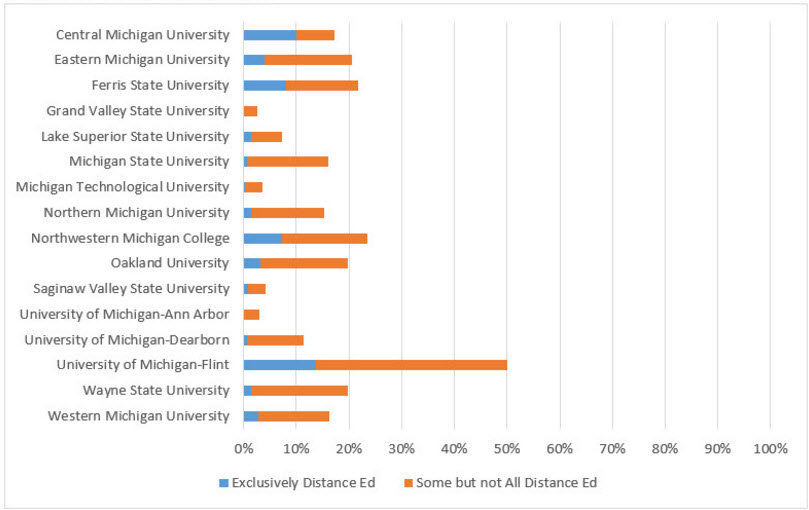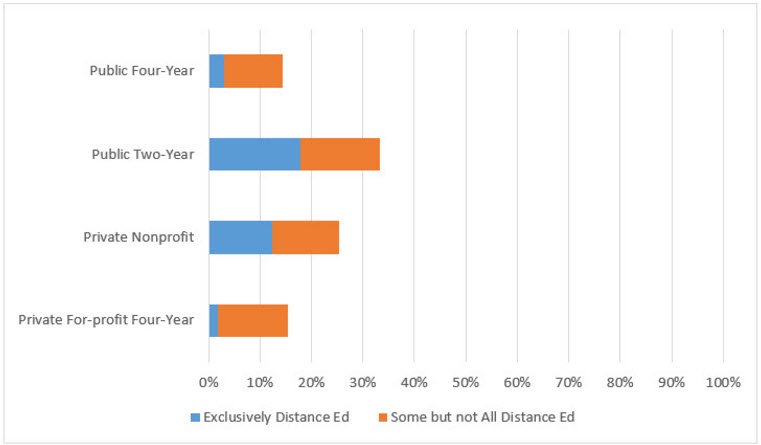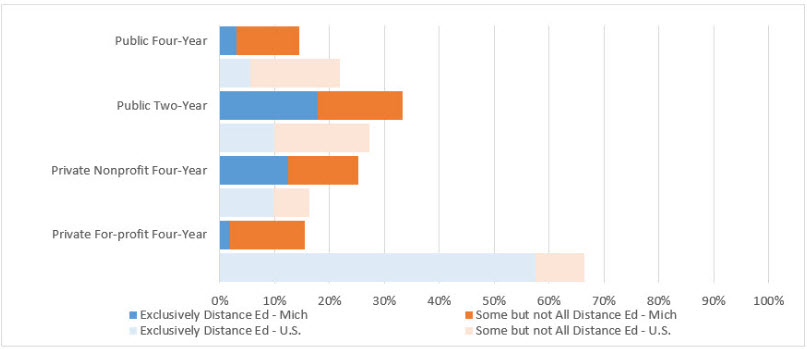In a previous blog post, we’ve examined online and distance education enrollment rates at postsecondary institutions across the United States. In this post, we’ll provide some local context by examining distance education enrollment rates at both public and private four-year institutions of higher education, as well as public two-year institutions, here in Michigan.
The data sets presented here also focus exclusively on degree-granting Title IV institutions. The compiled figures were retrieved from the spring 2013 Integrated Postsecondary Education Data System (IPEDS) collection cycle and represent the most recent year for which data are available. Please refer to our previous blog post to learn more about the collection process, the system’s definition of distance education, and the data system itself.
Public Four-Year Institutions
Fifteen schools were identified as degree-granting, four-year public institutions within the state of Michigan with a total undergraduate enrollment of 239,538. Of that total, only 3% (7,091 students) were enrolled exclusively in distance education courses, while 27,630 students, or 11.5%, were enrolled in at least one distance education course.
During the same school year, Central Michigan University reported 2,044 (10%) undergraduate students enrolled exclusively in distance education courses in 2013, the largest total of the 15 schools. The University of Michigan – Flint had the highest percentage of undergraduate students enrolled exclusively in distance education courses (13.7%) as well as the highest enrollment in some but not all distance education courses (36.4%). Michigan State University had 5,832 undergraduate students who took at least some distance education courses that year, 15.4% of its total student count. Refer to Figure 1 for totals for all 15 institutions.

Public Two-Year Institutions
Thirty schools were identified as Title IV degree-granting, public two-year colleges in Michigan, with a 2013 school year total student count of 222,286. Of this group, 7.9% were enrolled exclusively in distance education courses, while 15.4% were enrolled in some but not all distance education courses. These are noteworthy percentage increases over the public four-year group (3.0% and 11.5%, respectively). Schoolcraft College, in Livonia, accounted for the largest number of students exclusively enrolled in distance education courses: 3,311, or 26.7% of its total student population. Lansing Community College reported 5,615 (32%) students enrolled in at least some distance education courses.
Private, Nonprofit Four-Year Institutions
There are 51 private, nonprofit Title IV institutions represented in this data set. In 2013, 17,209 (15.9%) of the 108,188 students enrolled in these institutions were enrolled exclusively in distance education courses. Those enrolled in some but not all distance education courses accounted for 12.9% of the total student population in this group. Baker College Center for Graduate Studies enrolled the most students in exclusively distance education courses, as over 99% of its 5,270 students fell into this category. At Davenport University, 2,159 (29.4%) of its total student population in 2013 were enrolled exclusively in distance education courses. Nearly 88% of undergraduate students at the Michigan Jewish Institute took at least some distance education courses, while Davenport had the highest actual number of students in this category. It is also interesting to note the distribution of distance education enrollments among the thirty schools in this group. A small number of schools, including Baker College Center for Graduate Studies, Davenport University, and Madonna College, accounted for a substantial amount of the distance education enrollments, while other large schools in this group, such as Kalamazoo College, Hope College, and Spring Arbor University, had little to no distance education enrollments.
Private, For-Profit Four-Year Institutions
Of the 15 private, four-year for-profit schools, only two reported student enrollment in exclusively distance education courses: DeVry University – Michigan and the International Academy of Design and Technology – Troy. These 104 students accounted for only 1.9% of all students in this group for 2013. There were 756 (14.6%) students included in this group who took at least some distance education courses. The Art Institute of Michigan accounted for the most students, 363 (36.2%),in some distance education, while the school with the highest percentage was South University – Novi with 50.3% (178 total). It should be noted that this data set does not capture much larger institutions that enroll Michigan students but are not considered Michigan-based schools, such as the University of Phoenix, or for that matter, any out-of-state institution that serves Michigan residents from outside the state.
Conclusion
Of the types of institutions observed for this study, public two-year and private nonprofit four-year schools in Michigan are the leaders when it comes to undergraduate distance education enrollment. Undergraduates attending a public two-year college in Michigan are much more likely to take at least some distance education courses than if they were to attend a public four-year school.

It’s important to consider these enrollment figures in contrast to the national data that we highlighted in our previous post . Only 14.5% of undergraduates at public four-year universities in Michigan took at least one distance education course in 2013, a lower tally than the figure of 21.8% nationwide in 2012. Public two-year and private for-profit four-year schools in Michigan slightly outpace the national average in terms of undergraduate enrollment in distance education courses. Despite Michigan being a recognized leader in the area of K-12 online learning, as evidenced by its state curriculum’s online learning requirement, its public four-year universities lag behind the national average when it comes to the use of distance education.

Though the Michigan data presented here represents only undergraduate enrollment from the 2013 collection year, a comparison of distance enrollment totals in 2012 reveals a growth trend at each type of institution. Additionally, changes to Section 21f of the State School Aid Act, which outlines some of the regulations around online learning at the K-12 level, now allow community colleges to offer courses directly to any public school students in grades 6-12 through the statewide online course catalog.
It’s clear that online learning is a well-established practice at many postsecondary institutions in the state and will likely be growing as time passes. It’s important to ensure that students are prepared and comfortable learning in such an environment. Our next post in this series will take a look at how Michigan universities are communicating that importance to prospective students.
